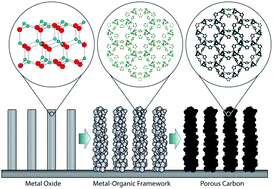Controlling the morphology of metal–organic frameworks and porous carbon materials: metal oxides as primary architecture-directing agents
Abstract
Owing to their large ratio of surface area to mass and volume, metal–organic frameworks and porous carbons have revolutionized many applications that rely on chemical and physical interactions at surfaces. However, a major challenge today is to shape these porous materials to translate their enhanced performance from the laboratory into macroscopic real-world applications. In this review, we give a comprehensive overview of how the precise morphology control of metal oxides can be transferred to metal–organic frameworks and porous carbon materials. As such, tailored material structures can be designed in 0D, 1D, 2D, and 3D with considerable implications for applications such as in energy storage, catalysis and nanomedicine. Therefore, we predict that major research advances in morphology control of metal–organic frameworks and porous carbons will facilitate the use of these materials in addressing major needs of the society, especially the grand challenges of energy, health, and environment.



 Please wait while we load your content...
Please wait while we load your content...